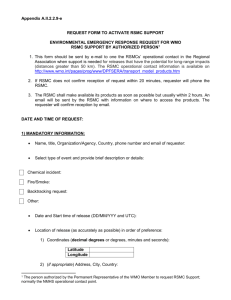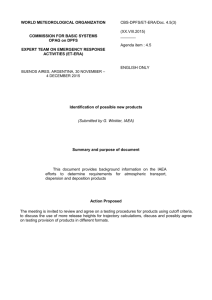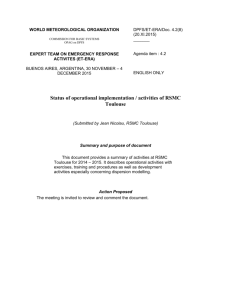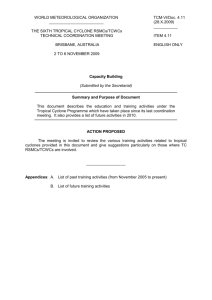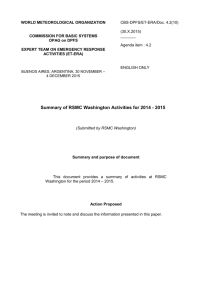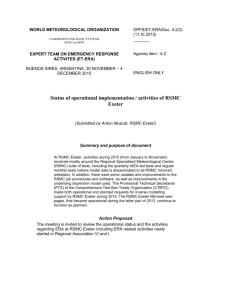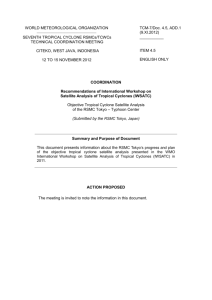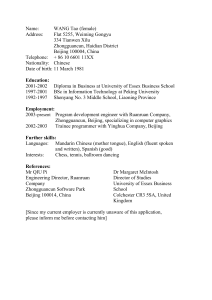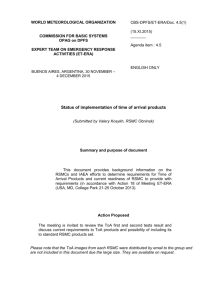RSMC Beijing
advertisement
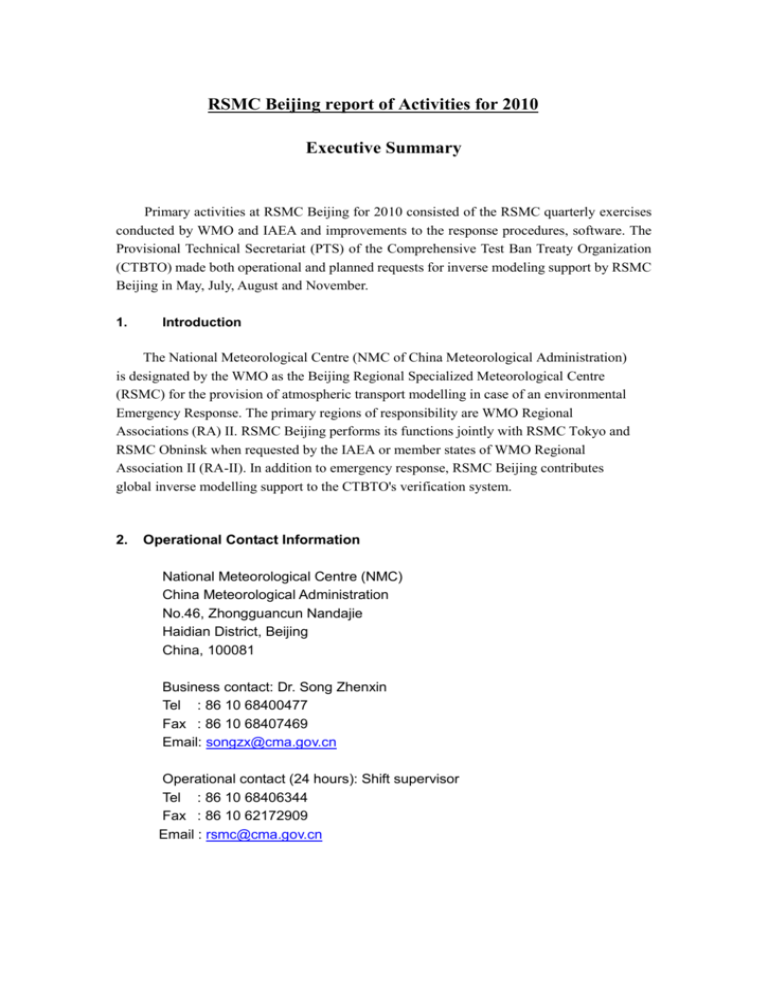
RSMC Beijing report of Activities for 2010 Executive Summary Primary activities at RSMC Beijing for 2010 consisted of the RSMC quarterly exercises conducted by WMO and IAEA and improvements to the response procedures, software. The Provisional Technical Secretariat (PTS) of the Comprehensive Test Ban Treaty Organization (CTBTO) made both operational and planned requests for inverse modeling support by RSMC Beijing in May, July, August and November. 1. Introduction The National Meteorological Centre (NMC of China Meteorological Administration) is designated by the WMO as the Beijing Regional Specialized Meteorological Centre (RSMC) for the provision of atmospheric transport modelling in case of an environmental Emergency Response. The primary regions of responsibility are WMO Regional Associations (RA) II. RSMC Beijing performs its functions jointly with RSMC Tokyo and RSMC Obninsk when requested by the IAEA or member states of WMO Regional Association II (RA-II). In addition to emergency response, RSMC Beijing contributes global inverse modelling support to the CTBTO's verification system. 2. Operational Contact Information National Meteorological Centre (NMC) China Meteorological Administration No.46, Zhongguancun Nandajie Haidian District, Beijing China, 100081 Business contact: Dr. Song Zhenxin Tel : 86 10 68400477 Fax : 86 10 68407469 Email: songzx@cma.gov.cn Operational contact (24 hours): Shift supervisor Tel : 86 10 68406344 Fax : 86 10 62172909 Email : rsmc@cma.gov.cn 3. Responses and information on dissemination of products i. Exercises (2010) October 29 – RSMC Beijing participated in the non-routine exercise. The release site was Lingao, China, and real-time weather was considered. RSMC Beijing received IAEA faxed request for transport and dispersion modelling of radionuclide in support of the exercise. November 18-19 – RSMC Beijing participated in the ConvEx-2c exercise. The release site was Hamaoka, Japan, and real-time weather was considered. RSMC Beijing received IAEA faxed request for transport and dispersion modelling of radionuclide in support of the exercise. ii. Dissemination of products Transport model graphical products and joint statements are posted to secure joint web pages, and faxed to relevant RSMCs and NMHSs. In addition to the other RSMCs, the following NMHSs are in our fax lists: Bahrain Bangladesh China Democratic people’s republic of Korea Hong Kong,China India Iran,Islanmic Republic of Iraq Republic of Yemen Japan Kazakstan Kyrgystan Macao Mongolia Myanmar Oman Pakistan Qatar Republic of Korea Saudi Arabia Sri Lanka Tajikistan Thailand Turkmenistan United Arab Emirates Uzbekistan Viet Nam The failure rate of fax transmission is high. During these exercises, only 12 out of 24 fax transmissions to NMHSs were successful: Democratic people’s republic of Korea Hong Kong, China Kyrgystan Macao Mongolia Republic of Korea Saudi Arabia Tajikistan Turkmenistan United Arab Emirates Uzbekistan Viet Nam iii. Response to requests by CTBTO-PTS There were a total of 13 requests from the Provisional Technical Secretariat of the Comprehensive Test Ban Treaty Organization. The requests were part of the CTBTO-WMO Exercise 2010, received on May 3, May 18-19, July 20, August 5, and November 4-13. In all cases, the products were supplied to CTBTO within a few hours of receiving the request. 4. Routine operations Quarterly Tests: RSMC Beijing participated in quarterly tests conducted by IAEA. Table 1 contains summary information on these tests. The results of the tests were uploaded to RSMC Beijing website and to Joint RSMC secure Webpage. Month February Source location Jakarta INDONESIA Initiated by WMO Regional Associations IAEA V May Darlington CANADA IAEA IV August Dukovany Check Republic IAEA VI Month October November Source location Initiated by WMO Regional Associations Lingao, China IAEA II1 Hamaoka, Japan IAEA II2 Table 1: RSMC quarterly tests for 2010 Notes: 1. Non-routine exercise. 2. ConvEx-2c. The RSMCs products we also faxed to NMHSs in WMO RA II, in accordance with existing procedures. 5. Significant operational or technical changes: HYSPLIT4.9 has been compiled successfully (except the graphic programs) and was put into operation in 2010. The text message communication platform was set up for sending text messages when receiving RSMC@cma.gov.cn e-mails. 6. Operational issues and challenges: 7. Some NMHSs’ contact information is out of date. Time difference and different languages cause some inconvenience. Summary and status of the operational atmospheric transport and dispersion models .The operational Environmental Emergency Response(EER) system, in RSMC Beijing, is currently based on the Hybrid Single-Particle Lagrangian Integrated Trajectories (HYSPLIT4) Atmospheric Transport Model, developed at the NOAA Air Resources Laboratory. HYSPLIT4 is driven by meteorological input resulting from the operational numerical weather prediction system T213L31 global model and the WRF medium model. The system is available for running on demand and produce forecast trajectories, concentrations (or exposures) and depositions for nuclear accident, volcanic ash, smoke and other episodes. In 2010, the HYSPLIT version was updated to HYSPLIT 4.9 version. The HYSPTLIT4 is used for modeling atmospheric transport and dispersion of pollutants over medium and long ranges of distances. The equations used in the calculation of pollutant transport and dispersion are a hybrid between Eulerian and Lagrangian approaches. Advection and diffusion calculations are made in a Lagrangian framework using the meteorological girded analysis and forecast fields. Air concentrations are calculated on a fixed three dimensional grid by integrating all particle masses over a pre-set averaging period. Routine calculations may consist of simple trajectories from a single source to consideration of complex emissions from several sources. Dry deposition is treated with the deposition velocity concept. Wet deposition is divided into two processes: a scavenging ratio for pollutants located within a cloud layer and a scavenging coefficient for pollutant removal in rain blow a cloud layer. Radiological decay is also included when necessary. 8. Plans for 2011: The schedule of tests (quarterly and others) has been defined in collaboration with the IAEA. Update the global Environmental Emergency Response (EER) system using the most recent UNIX version HYSPLIT4 model with input from the new operational numerical weather prediction system T639. Optimize the emergency response procedures, software.
